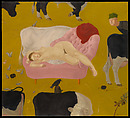Susanna and the Elder
Honoré Sharrer American
Not on view
Celebrated in the 1950s for her meticulous figurative paintings that subtly critiqued the socio-political environment of post-World War II New York, Sharrer turned to magic realism late in her career, rendering odd and highly charged scenes in a luminous palette reminiscent of the Flemish painters she admired. A committed communist, she resisted the oppressive constraints of the Cold War-era through subversive visual strategies, by incorporating subtle references to her leftist politics within surrealist settings. These views cast undue attention on the artist, who was forced to move to Canada in the 1950s amid a rise of anti-communist sentiment. Away from the New York art world, Sharrer was marginalized, not just for her politics, but for her gender and use of realistic figuration at a time when masculinized Abstract Expressionism was the dominant painterly form.
While her earlier paintings ennobled working-class subjects, her compositions of the 1970s and 1980s largely constitute feminist reworkings of ancient myths. These works, executed with studied precision, are unquestionably strange, incorporating skewed perspectives, flattened planes of bright color, and surprising juxtapositions. Confidently naked women frequently appear alongside clothed men, animals, and unusual objects in bizarre figural groupings that recall Renaissance paintings.
This dream-like composition depicts a fantastical situation in realistic detail, as a nude woman reclines in confident repose on a plush pink daybed. A dairy farmer peers in from the right of the canvas while a herd of cows unwittingly wanders around the edges. Set in an ambiguous space against a mustard-colored ground, this vibrantly painted scene reimagines the story of Susanna and the Elders, a Biblical narrative from the Book of Daniel. In that account, a bathing woman is spied on by lecherous voyeurs who try to discredit her reputation when she refuses their advances, only to be exposed as prurient liars. Here, Sharrer recasts the Elder as a curious farmer and paints the woman in a pose of erotic self-presentation, in control of her body rather than ashamed of her nakedness. Not the demure Susanna of 17th-century Baroque paintings, she arranges herself for display. In this the artist seems to quote a 1938–39 painting by Thomas Hart Benton (see Rape of Persephone, The Nelson-Atkins Museum of Art, Kansas City, F86-57), who depicts the mythological Rape of Persephone as a confrontation between a napping nude country girl and a leering elderly farmer. The dynamics of power present in these scenes raise questions today about female modesty and issues of consent. Yet Sharrer decenters the male gaze to focus instead on the central female figure and her personal agency, setting a different tone for the Elder’s encounter with Susanna.
This image cannot be enlarged, viewed at full screen, or downloaded.

